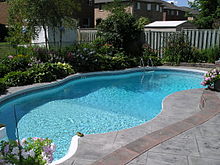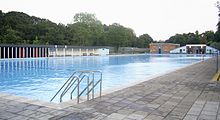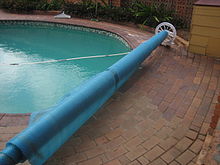Swimming pool
Specially designed swimming pools are also used for diving, water sports, and physical therapy, as well as for the training of lifeguards and astronauts.[1] Ancient Greeks and Romans built artificial pools for athletic training in the palaestras, for nautical games and for military exercises.[3] Ancient Sinhalese built a pair of pools called "Kuttam Pokuna" in the kingdom of Anuradhapura, Sri Lanka, in the 6th century AD.The South East Gazette July 1844 reported an aquatic breakfast party: coffee and biscuits were served on a floating raft in the river.[8] The presence of indoor baths in the cobbled area of Merton Street might have persuaded the less hardy of the aquatic brigade to join.[12] A two-storey, white concrete swimming pool building composed of horizontal cubic volumes built in 1959 at the Royal Roads Military College is on the Canadian Register of Historic Places.[15] The largest indoor wave pool in the world is at DreamWorks Water Park within the American Dream shopping and entertainment complex at the Meadowlands Sports Complex in East Rutherford, New Jersey, United States, and the largest indoor pool in North America is at the Neutral Buoyancy Lab in the Sonny Carter Training Facility at NASA JSC in Houston.[21] In Europe, the largest swimming pool opened in 1934 in Elbląg (Poland), providing a water area of 33,500 square metres (361,000 sq ft).[22] One of the largest swimming pools ever built was reputedly created in Moscow after the Palace of Soviets remained uncompleted.Privately owned outdoor pools in backyards or gardens started to proliferate in the 1950s in regions with warm summer climates, particularly in the United States with desegregation.The main types of in-ground pools are gunite shotcrete, concrete, vinyl-lined, and one-piece fiberglass shells.There are also elaborate pools with artificial waterfalls, fountains, splash pads, wave machines, varying depths of water, bridges, and island bars.Competition pools are generally indoors and heated to enable their use all year round, and to more easily comply with the regulations regarding temperature, lighting, and automatic officiating equipment.[30] Some design considerations allow the reduction of swimming resistance making the pool faster: namely, proper pool depth, elimination of currents, increased lane width, energy absorbing racing lane lines and gutters, and the use of other innovative hydraulic, acoustic and illumination designs.These consist of a small vessel (usually about 2.5 × 5 m) in which the swimmer swims in place, either against the push of an artificially generated water current or against the pull of restraining devices.with the innovation of the pre-form composite method where mosaic tiles are bonded to the shell this enables commercial spas to be completely factory manufactured to specification and delivered in one piece.Hot tubs are typically made somewhat like a wine barrel with straight sides, from wood such as Californian redwood held in place by metal hoops.Immersion of the head is not recommended in spas or hot tubs due to a potential risk of underwater entrapment from the pump suction forces.Upmarket spas often include a drinks tray, lights, LCD flat-screen TV sets and other features that make the pool a recreation center.Many pools are incorporated in a redwood or simulated wood surround, and are termed "portable" as they may be placed on a patio rather than sunken into a permanent location.Despite the development of chlorinated and heated pools, ocean baths remain a popular form of recreation in New South Wales.[citation needed] Natural pools were developed in central and western Europe in the early and mid-1980s by designers and landscape architects with environmental concerns.[citation needed] Natural pools, by requiring a water garden to be a part of the system, offer different aesthetic options and can support amphibious wildlife such as snails, frogs, and salamanders, and even small fish if desired.[34] Architecturally, an indoor pool may look like the rest of the building, but extra heating and ventilation and other engineering solutions are required to ensure comfortable humidity levels.In addition to drainage and automatic pool covers, there are a number of ways to remove the humidity present in the air in any wet indoor environment.By taking steps to properly secure the pool, it lessens the likelihood that the superstructure will be damaged or compromised by freezing water.The innovation of a composite construction of fiberglass, with an epoxy coating and porcelain ceramic tiles has led to the pre-form, composite-type with significant advantages over older methods; however, it also has increased sensitivity to metal staining.[citation needed] Pools pose a risk of drowning, which may be significant for swimmers who are inexperienced, suffer from seizures, or are susceptible to a heart or respiratory condition.Lifeguards are employed at most pools to execute water rescues and administer first aid as needed in order to reduce this risk.[44] When diving from a high board, swimsuits are sometimes worn doubled up (one brief inside another) in case the outer suit tears on impact with the water.























Swimming pool (disambiguation)BackyardOlympic-size swimming poolMelbourne Sports and Aquatic Centre2006 Commonwealth GamesMelbourneswimmingconcretefiberglasshealth clubsfitness centersnatatoriumsleisure centersconvention centersHot tubsrelaxationhydrotherapydivingphysical therapylifeguardsastronautsHistory of water supply and sanitationGreat BathMohenjo-DaroAncient GreeksRomanspalaestrasGaius Maecenashis gardensEsquiline HillAugustusSinhaleseKuttam PokunaAnuradhapuraMaidstoneRiver Medwaywater poloAmateur Swimming AssociationMerton StreetOxfordOlympic GamesRacquet Club of PhiladelphiaWhite Star LineAdriaticBelmont, MassachusettsYrjönkatu Swimming HallKamppiHelsinkiWorld War IWorld War IIEsther WilliamsMillion Dollar MermaidRoyal Roads Military CollegeCanadian Register of Historic PlacesList of largest swimming poolsMoskva PoolGuinness World RecordsSan Alfonso del MarAlgarrobowave poolDreamWorks Water ParkAmerican DreamMeadowlands Sports ComplexEast Rutherford, New JerseyNeutral Buoyancy LabSonny Carter Training FacilityDeep Dive DubaiGuinness Book of World RecordsHotel Terme MillepiniFleishhacker PoolkayaksElblągPolandMoscowPalace of Sovietsde-StalinisationcommunismChrist the Saviour CathedralYangbajainhot springsCairnsManhattanshort courselong course metersUSA SwimmingOlympic swimming pooldesegregationshotcretepool fencingChildren's Pool Beachpolyvinyl chlorideLabrador RetrieverTooting Bec Lidoleisure centerchlorinatedsaltwaterozonatedjacuzzisnatatoriumdiving boardrectanglesartificial waterfallssplash padslockersUniversity of MinnesotaSummer OlympicsFédération Internationale de la Natation1924 OlympicsTouchpadsresistanceswimming machinesresistance swimmingHot tubhealth clubmosaicwine barrelCalifornian redwooddepartment storesacrylicPerspexmarbleredwoodJacuzzinozzlesventuri pumpgeothermal